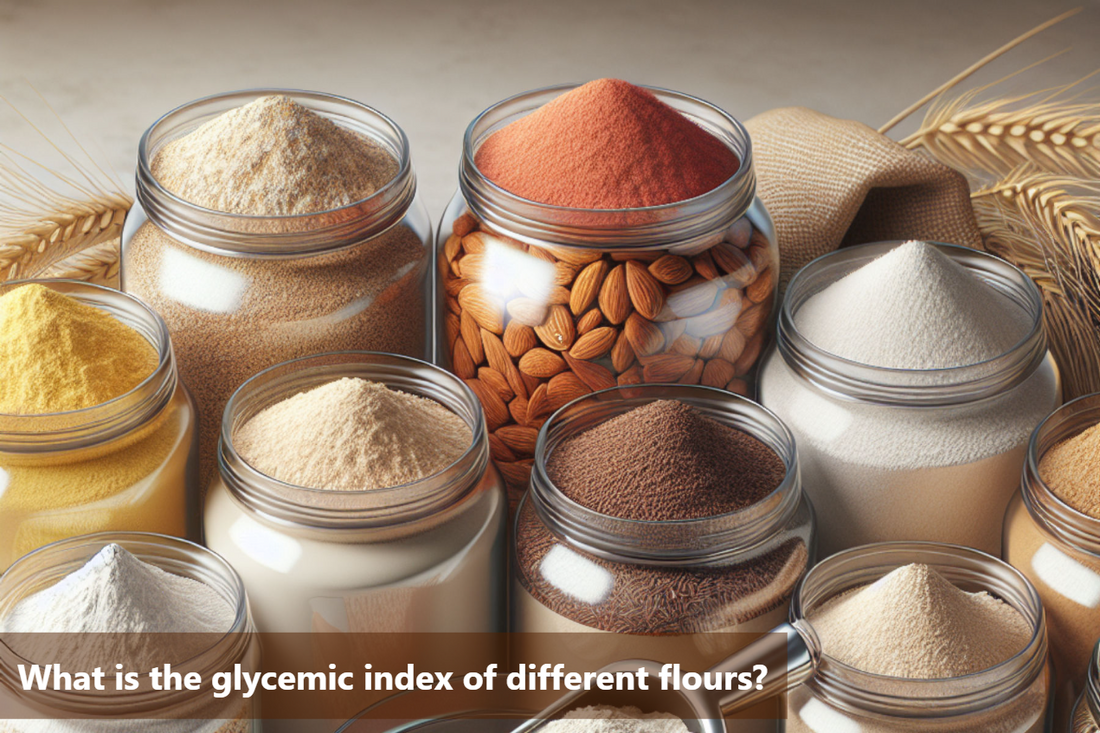The glycemic index (GI) serves as a pivotal indicator of how different foods affect our blood sugar levels. When it comes to various types of flour, understanding their GI can significantly impact our dietary choices and overall health. In this blog post, we delve into the realms of GI.
When we consider the GI of flour, we are essentially looking at how quickly they cause blood sugar levels to rise. This information is crucial for individuals, especially those monitoring their blood sugar levels, aiming for weight management, or seeking sustained energy levels.
The aim of this blog post is to unravel the diverse glycemic index values associated with different types of flour. By exploring the GI of wheat flour, ragi flour, corn flour, barley flour, and jowar flour, we aim to empower our readers to make informed decisions when selecting flour for their meals. Understanding these variations can assist in crafting a balanced diet that promotes stable blood sugar levels and overall well-being.
Glycemic Index of Wheat Flour
Type of Flour |
Source |
Glycemic Index Range |
|---|---|---|
White wheat flour |
Wheat |
70 - 85 |
Whole wheat flour |
Wheat |
50 - 70 |
Whole grain flour |
Various grains (e.g., barley, oats) |
Below 70 |
Almond flour |
Almonds |
0 - 20 |
Coconut flour |
Coconut |
45 - 55 |
Buckwheat flour |
Buckwheat |
45 - 55 |
Quinoa flour |
Quinoa |
53 - 55 |
Spelt flour |
Spelt wheat |
54 - 77 |
Amaranth flour |
Amaranth seeds |
65 |
Barley flour |
Barley |
60 - 70 |
Brown rice flour |
Brown rice |
50 - 62 |
Chickpea flour (besan) |
Chickpeas |
33 - 43 |
Lentil flour |
Lentils |
21 - 30 |
Rye flour |
Rye |
40 - 50 |
Tapioca flour |
Cassava (Tapioca root) |
65 - 70 |
Corn flour |
Corn |
70 - 75 |
Hazelnut flour |
Hazelnuts |
15 - 25 |
Potato flour |
Potatoes |
75 - 85 |
Teff flour |
Teff grains |
30 - 40 |
Chestnut flour |
Chestnuts |
65 - 70 |
Sorghum flour |
Sorghum grains |
60 - 70 |
Green pea flour |
Green peas |
22 - 35 |
Millet flour |
Millet grains |
70 - 80 |
Chickpea flour (gram flour) |
Chickpeas |
33 - 43 |
Cassava flour |
Cassava root |
65 - 70 |
Oat flour |
Oats |
45 - 55 |
Soy flour |
Soybeans |
25 - 50 |
Chestnut flour |
Chestnuts |
65 - 70 |
Sunflower seed flour |
Sunflower seeds |
40 - 50 |
Lowest and Highest Glycemic Index of Flour
The glycemic index (GI) of flours can vary depending on factors such as processing method, particle size, and the type of grain or seed used. Generally, refined flours tend to have higher glycemic index values compared to whole grain or nut-based flours. Here's a comparison of some flours with their approximate glycemic index ranges:
Highest Glycemic Index Flours:
White wheat flour: Refined white wheat flour typically has a high glycemic index, ranging from 70 to 85.
Rice flour (white): White rice flour, which is made from polished rice grains, has a high glycemic index ranging from 70 to 87.
Potato flour: Potato flour, made from dried potatoes, has a high glycemic index, typically ranging from 75 to 85.
Corn flour (maize flour): Corn flour, especially refined corn flour, can have a high glycemic index, ranging from 70 to 75.
Tapioca flour (cassava flour): Tapioca flour, derived from the cassava root, has a high glycemic index, typically ranging from 65 to 70.
Lowest Glycemic Index Flours:
Almond flour: Almond flour, made from ground almonds, has a low glycemic index, typically ranging from 0 to 20.
Coconut flour: Coconut flour, made from dried coconut meat, has a relatively low glycemic index, typically ranging from 45 to 55.
Chickpea flour (besan): Chickpea flour, made from ground chickpeas, has a moderate to low glycemic index, typically ranging from 33 to 43.
Lentil flour: Lentil flour, made from ground lentils, has a low glycemic index, typically ranging from 21 to 30.
Quinoa flour: Quinoa flour, made from ground quinoa grains, has a moderate to low glycemic index, typically ranging from 53 to 55.
- Diabesmart Sugar Care atta: Diabesmart Sugar Care atta is a specially formulated atta for diabetes management. The atta has low glycemic index as its made from peanut chickpea nd coconut flour.
Benefits of Low Glycemic Index Flour
The use of low glycemic index (GI) flour offers several potential benefits, particularly for individuals concerned about managing their blood sugar levels, promoting overall health, and preventing chronic diseases. Here are some of the benefits of incorporating low GI flour into the diet:
Blood sugar management: Low GI flour causes a slower and more gradual increase in blood sugar levels compared to high GI flour. This slower release of glucose into the bloodstream helps prevent spikes and crashes in blood sugar, promoting more stable and balanced blood sugar levels over time. This benefit is especially important for individuals with diabetes or those at risk of developing diabetes, as it can help improve glycemic control and reduce the risk of complications associated with poorly managed blood sugar levels.
Weight management: Low GI foods, including low GI flour, tend to be more filling and satiating than high GI foods. Consuming foods made with low GI flour can help individuals feel fuller for longer periods, reducing hunger and the likelihood of overeating. This can aid in weight management efforts by promoting better portion control, reducing calorie intake, and supporting sustainable weight loss or weight maintenance.
Energy levels: Foods made with low GI flour provide a steady and sustained release of energy, helping to maintain consistent energy levels throughout the day. This can prevent energy crashes and fatigue, promoting better concentration, focus, and productivity. Additionally, sustained energy from low GI foods can support physical performance and endurance during exercise or sports activities.
Heart health: Low GI diets have been associated with several cardiovascular benefits, including improved lipid profiles (e.g., lower levels of LDL cholesterol and triglycerides), reduced inflammation, and improved insulin sensitivity. Consuming foods made with low GI flour as part of a heart-healthy diet can help lower the risk of heart disease, stroke, and other cardiovascular conditions.
Digestive health: Low GI flour is often made from whole grains or alternative flours such as almond flour or coconut flour, which are rich in dietary fiber. Fiber is important for digestive health as it promotes regular bowel movements, prevents constipation, and supports a healthy gut microbiome. Including low GI flour in the diet can help increase fiber intake and support optimal digestive function.
Nutrient density: Many low GI flours, such as whole grain flours or nut-based flours, are rich in essential nutrients such as vitamins, minerals, antioxidants, and healthy fats. By choosing low GI flour options, individuals can increase their intake of nutrients that are important for overall health and well-being, including fiber, protein, vitamins B and E, magnesium, and zinc.
Overall, incorporating low GI flour into the diet can be a valuable strategy for promoting optimal health, managing blood sugar levels.
Bottom Line
Choosing flour for a healthy diet relies on understanding the glycemic index. This blog highlights the glycemic index values of wheat flour, ragi, corn, barley, and jowar. Wheat flour has a higher glycemic index than ragi, corn, barley, and jowar, causing quicker blood sugar spikes. Opt for lower GI flours like ragi, corn, barley, or jowar for stable blood sugar levels. Replace high GI flours gradually with these alternatives in recipes like chapatis or baked goods to improve health.
Only Low Glycemic Index isn’t usually enough to be Diabetic Friendly. Sugar Care Atta is the only Flour in India that has been Clinically tested on Diabetics and Pre-Diabetics to show 55% Lower Sugar Spikes compared to regular Flours. This makes it effective for blood sugar management. The taste and texture is also similar to regular Rotis and Chapatis made at home.
This Blog post is an initiative by DiabeSmart, to provide accurate and Nutritionist / Doctor approved information related to Diabetes. DiabeSmart is India's first Food brand designed specifically for Diabetics, that has been clinically tested on Diabetics and Pre-Diabetics to deliver 55% - 70% lower Sugar spikes. DiabeSmart is part of Lo! Foods - India's leading brand for Everyday Functional Health foods.















